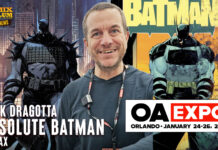There can be only one.
As impossible as it seems, there were fantasy films made before the Harry Potter series and The Lord of the Rings and Hobbit trilogies (or hexalogy?). Most of those suffered from inferior production values, over-the-top acting and decidedly poor special effects; elements that contributed to fantasy’s low regard by critics. However, there are many films that raised the genre’s reputation to the larger public. Fantasy films have been around almost as long as the medium itself, most notably A Trip to the Moon from 1902. The advent of sound in films introduced audiences to Tarzan the Ape Man (1932), King Kong (1933) and The Wizard of Oz (1939).
It’s a Wonderful Life (1946), A Christmas Carol and Disney’s Alice in Wonderland (both 1951) were notable standouts for the post-war era, though it wasn’t until the late 50’s onwards that sword and sorcery fantasy films became popular. These heroic fantasy films were generally characterized by sword-wielding heroes engaged in high adventure and violent conflicts. Most of these were low-budget fantasies based on Greek mythology, but they were notable for featuring the special effects of legend Ray Harryhausen. Harryhausen’s masterwork was Jason and the Argonauts (1963) for its use of stop-motion animated statues, skeletons, harpies, hydra, and other mythological creatures.
It wasn’t until the 80’s where fantasy films saw an explosion in popularity; high-tech filmmaking techniques, more realistic special effects and increased audience interest caused the genre to flourish. Sword and sorcery was especially popular, and the 80’s saw a trend in mixing modern settings and action film sequences with exotic, fantasy concepts. None did this with more flair than 1986’s Highlander, directed by Russell Mulcahy.
Mulcahy was one of the most prominent music video directors of the 80’s; his landmark video for The Buggles’ “Video Killed the Radio Star” (1979) became the first music video played on MTV in 1981 (yes, Virginia, videos were played on MTV before there was You Tube). Mulcahy directed videos for some of the most successful pop-rock acts of the period including Elton John, Duran Duran, Rod Stewart, Billy Joel, Supertramp and The Rolling Stones. His work is recognizable by the use of fast cuts, tracking shots and the use of glowing lights. That apprenticeship served him well in his transition to feature film, especially Highlander, with its quick cuts and rocking soundtrack by Queen. This is a 110 minute music video.
Christopher Lambert stars as Connor MacLeod, a reluctant member of a secret society of near-invulnerable immortals who participate in what they call “The Game”, an eternal contest that will only end at the time of “The Gathering”, when the final immortals are drawn together to battle each other until only one is left standing. The last immortal, in turn, will receive what is only known as the Prize, the combined power taken from each immortal as they are killed. It’s 1985 and The Gathering is set to take place in New York City where the freaks do come out at night (Whodini were right). The immortals can only die by beheading, so there are sword fights aplenty. MacLeod, using an alias, is one of the last immortals vying for the Prize, having killed a fellow immortal in the garage of Madison Square Garden. Standing in his way is the Kurgan (Clancy Brown), the most powerful and evil of the immortals. At the same time, MacLeod is pursed by Brenda Wyatt (Roxanne Hart), a metallurgist working for the police who is fascinated with the case and MacLeod as the prime suspect, and you can fill in the blanks for the love story here.
The film flashbacks to MacLeod’s life in 1500’s Scotland, where he first learns of his immortality from a battle with the Kurgan and tutelage from Juan Sanchez Villa-Lobos Ramirez (Sean Connery), who mentors him in the ways of immortal life and survival, which includes honing his sword-fighting skills and concealing his secret. We understand MacLeod’s reluctance to the immortal life when he outlives his wife, a painful experience Ramirez warned him of that sets up the lost and lonely man we see in the present and the draw he has towards Brenda, who reminds MacLeod of his late wife.
Highlander was Lambert’s breakout role; his only other American film at the time was Greystoke: The Legend of Tarzan, Lord of the Apes and he had previously appeared in supporting roles of several French films. Lambert parlayed a decent career for himself, appearing in many sci-fi, action and thriller films, such as Knight Moves (1992), Fortress (1994), and most notably Mortal Kombat (1995) as Raiden. For Highlander, Lambert spent time with a dialogue coach, learning to speak English and developing an accent which sounded non-specifically foreign. Lambert may not sound authentically Scottish, but he conveys the weariness of a man who continues to outlive his loved ones and, to prevent that from happening again, builds a wall around his heart and lives in immortal solitude.
Connery is all dashing and delightful as the swashbuckler Ramirez. What’s awesome is the character is an ancient Egyptian disguised as a Spaniard, yet Connery makes no effort to conceal his Scottish brogue. Connery became as superstar due to his portrayal as Agent 007 in the James Bond films, but he eventually tired of the role and the pressure the franchise put on him. “[I am] fed up to here with the whole Bond bit”, he said in a 1965 Playboy interview. Being typecast certainly had its constraints; apart from The Man Who Would Be King and The Wind and the Lion (both 1975), most of Connery’s successes in the 70’s were as part of ensemble casts in films such as Murder on the Orient Express (1974), A Bridge Too Far (1977), and The Great Train Robbery (1979). Connery was no stranger to fantasy films either, appearing in Time Bandits (1981) as Agamemnon and Sword of the Valiant (1984) as the Green Knight.
But it was in Highlander where Connery showcased his ability to play older mentors to younger leads, which became a recurring role in future films. In fact, Connery’s performance as a hard-nosed Irish-American cop in The Untouchables (1987) earned him the Academy Award for Best Supporting Actor, his sole nomination throughout his career. Connery also provided a breath of fresh air and levity as Professor Henry Jones, Sr. in Indiana Jones and the Last Crusade (1989).
Clancy Brown’s height, deep voice and large frame were all factors in the producers casting him as The Kurgan, and Brown puts in a great, menacing performance. The church scene involving Kurgan was filmed at night with the priest’s permission, and Brown’s lines were ad-libbed; apparently they were considered so sacrilegious that the priests off-camera were making the sign of the cross as he said them. Highlander launched his career, and he has played either villains or authority figures ever since, including Captain Hadley in The Shawshank Redemption (1994), Sgt. Zim in Starship Troopers (1997), and on TV as Sheriff August Corbin in Sleepy Hollow (2013), as well as countless voice acting work in animated superhero shows.
The icing on the cake is the soundtrack. The orchestral score was composed by Michael Kamen, and the soundtrack includes several songs by Queen, such as “A Kind of Magic” and “Princes of the Universe”. Queen wrote many of the songs to specifically match the mood of the scenes when the songs are heard; Brian May’s “Who Wants to Live Forever” is a prime example, as the song focuses on the doomed love of Connor and his wife Heather.
Upon its initial release, Highlander was given a mediocre reception (at best) in the United States, but gained wide and persistent popularity in Europe as well as on home video. It currently holds a 67% fresh rating on Rotten Tomatoes and has its share of admirers among critics. Danél Griffin of Film as Art awarded the film four stars (out of four) and stated “the key to Highlander’s success is in its approach to its subject matter. What could have been a premise that breathes cliché is given a fresh approach due to Mulcahy’s unique directing style and a cleverly-written script.” The BBC’s Matt Ford gave the film three stars out of five and noted “from the moody, rain-soaked, noir-ish streets of late 20th century America to the wild open spaces of medieval Scotland, Mulcahy plunders movie history to set off his visceral fight scenes with suitably rugged locations.”
Highlander has since reached cult classic film status worldwide and became a franchise, spawning four mediocre sequels, a good television series, and various other spin-offs.
But that is a discussion for another article.
This article originally appeared in Comix Asylum Magazine Issue 9 (December 2014)





































